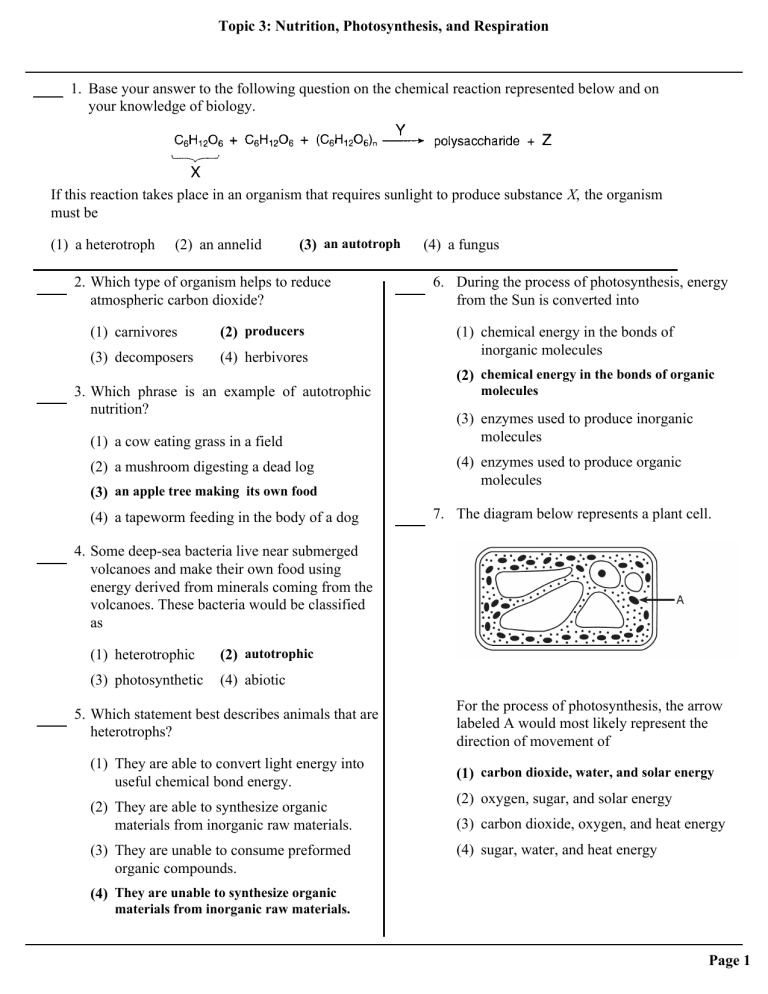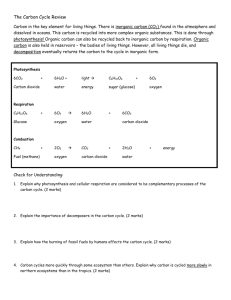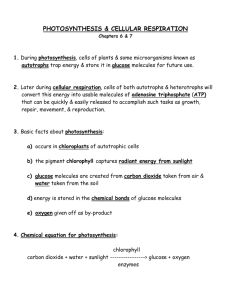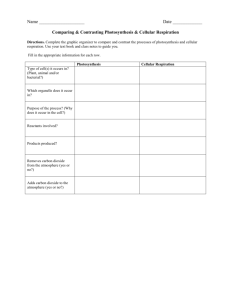Topic 3: Nutrition, Photosynthesis, and Respiration Page 1 1. Base

Topic 3: Nutrition, Photosynthesis, and Respiration
1. Base your answer to the following question on the chemical reaction represented below and on your knowledge of biology.
If this reaction takes place in an organism that requires sunlight to produce substance X , the organism must be
(1) a heterotroph (2) an annelid (3) an autotroph (4) a fungus
2. Which type of organism helps to reduce atmospheric carbon dioxide?
(1) carnivores
(3) decomposers
3. Which phrase is an example of autotrophic nutrition?
(2) producers
(4) herbivores
(1) a cow eating grass in a field
(2) a mushroom digesting a dead log
(3) an apple tree making its own food
(4) a tapeworm feeding in the body of a dog
4. Some deep-sea bacteria live near submerged volcanoes and make their own food using energy derived from minerals coming from the volcanoes. These bacteria would be classified as
(1) heterotrophic (2) autotrophic
(3) photosynthetic (4) abiotic
5. Which statement best describes animals that are heterotrophs?
(1) They are able to convert light energy into useful chemical bond energy.
(2) They are able to synthesize organic materials from inorganic raw materials.
(3) They are unable to consume preformed organic compounds.
(4) They are unable to synthesize organic materials from inorganic raw materials.
6. During the process of photosynthesis, energy from the Sun is converted into
(1) chemical energy in the bonds of inorganic molecules
(2) chemical energy in the bonds of organic molecules
(3) enzymes used to produce inorganic molecules
(4) enzymes used to produce organic molecules
7. The diagram below represents a plant cell.
For the process of photosynthesis, the arrow labeled A would most likely represent the direction of movement of
(1) carbon dioxide, water, and solar energy
(2) oxygen, sugar, and solar energy
(3) carbon dioxide, oxygen, and heat energy
(4) sugar, water, and heat energy
Page 1
Topic 3: Nutrition, Photosynthesis, and Respiration
Base your answers to questions 8 through 11 the diagram of a chloroplast below.
8. Carbon dioxide is represented by letter
(1) E (2) B (3) C (4) F
9. The process of photolysis (Light reactions) in the grana occurs at letter
(1) E (2) G (3) C (4) D
10.The dark reactions (Calvin Cycle) in the stroma are represented by letter
(1) A (2) F (3) C (4) D
11.Which of the following molecules are represented by letters E and F?
(1) Oxygen and Glucose
(3) Carbon Dioxide and Glucose
(2) Oxygen and Carbon Dioxide
(4) Carbon Dioxide and ATP
12. During the process of cellular respiration, energy is released from
(1) carbon dioxide
(2) oxygen atoms
(3) water molecules
(4) chemical bonds
13. Which term best defines a bacteria that can survive without oxygen?
(1) aerobic (2) anaerobic
(3) heterotrophic (4) saprophytic
Page 2
Topic 3: Nutrition, Photosynthesis, and Respiration
Base your answers to questions 14 and 15 on the information and diagram below and on your knowledge of biology.
A small water plant (elodea) was placed in bright sunlight for five hours as indicated below.
Bubbles of oxygen gas were observed being released from the plant.
14. What substance did the plant most likely absorb from the water in order to produce the oxygen gas?
(1) dissolved nitrogen
(3) an enzyme
(2) carbon dioxide
(4) a hormone
15. The bubbles of oxygen indicate that the plant is
(1) producing sugar
(3) releasing energy from water
(2) making protein
(4) carrying on active transport
16. The rate at which all organisms obtain, transform, and transport materials depends on an immediate supply of which resources?
(1) ATP and enzymes
(2) solar energy and carbon dioxide
(3) carbon dioxide and enzymes
(4) ATP and solar energy
17. In what way are photosynthesis and cellular respiration similar?
(1) They both occur in chloroplasts.
(2) They both require sunlight.
(3) They both involve organic and inorganic molecules.
(4) They both require oxygen and carbon dioxide. inorganic produce
Page 3
Topic 3: Nutrition, Photosynthesis, and Respiration
18. Base your answer to the following question on the diagram below which represents a cross section of part of a leaf.
21. The diagram below represents part of the process of cellular respiration.
Which life functions are directly regulated through feedback mechanisms associated with the actions of the structures labeled X?
(1) excretion and immunity
(2) digestion and coordination
(3) circulation and reproduction
(4) respiration and photosynthesis
19. The diagram below represents a cross section of a plant structure.
Energy is released and made available for metabolic activities at
(1) step 1, only
(2) step 2, only
(3) both step 1 and step 2
(4) neither step 1 nor step 2
22. The diagram below represents a biochemical process.
Which letter indicates the region where most autotrophic nutrition takes place?
(1) A (2) B (3) C (4) D
20. Which letter indicates the structure that allows the plant to exchange gases with the environment?
(1) A (2) E (3) D (4) B
Which molecule is represented by X ?
(1) DNA
(3) protein
(2) starch
(4) ATP
Page 4
Topic 3: Nutrition, Photosynthesis, and Respiration
Base your answers to questions 23 through 25 on the diagram below. The diagram represents plant photosynthetic activities taking place in a "food factory."
23. The chemical synthesis area most likely contains
(1) enzymes necessary for fermentation
(2) structural components known as grana
(3) enzymes necessary for carbon-fixation reactions
(4) structural components known as mitochondria
24. Which gas is represented by letter A ?
(1) oxygen
(3) methane
(2) nitrogen
(4) carbon dioxide
25. Which substance is most likely represented by letter B ?
(1) RNA (2) glucose (3) alcohol (4) auxin
Page 5
Topic 3: Nutrition, Photosynthesis, and Respiration
Base your answers to questions 26 through 29 on the diagram below, which is a concept map that shows the relationship between photosynthesis and respiration, and on your knowledge of biology.
26. In which cell organelle do the reactions that belong in areas B and C occur?
(1) mitochondrion
(3) endoplasmic reticulum
(2) chloroplast
(4) Golgi complex
27. Which molecule belongs in area X ?
(1) lactic acid
(3) water
(2) carbon dioxide
(4) oxygen
28. Which molecule belongs in area Y ?
(1) water (2) oxygen (3) glucose (4) hydrogen
29. Which molecule belongs in area A ?
(1) deoxyribonucleic acid
(3) PGAL
(2) adenosine triphosphate (ATP)
(4) C
6
H
12
O
6
Page 6
Topic 3: Nutrition, Photosynthesis, and Respiration
30. A biological process that occurs in both plants and animals is shown below.
Which row in the chart below identifies the lettered substances in this process?
(1) 1 (2) 2 (3) 3
31. The diagram below shows a sequence of events that often occurs in human muscle cells.
(4) 4
The substance represented by letter X is most likely
(1) hemoglobin (2) glycogen
(3) ethyl alcohol (4) lactic acid
Page 7
Base your answers to questions 32 and 33 on the information and diagram below and on your knowledge of biology.
Topic 3: Nutrition, Photosynthesis, and Respiration
34. The diagram below represents a cross section of a leaf.
A student conducted an investigation on fermentation. Yeast, molasses, and water were combined in a fermentation tube and left for several hours at room temperature. The results are shown below.
32. Which substance would most likely be found in the greatest amount in area X ?
(1) O
2
(3) H
2
O
(2) C
(4)
6
CO
H
2
12
O
6
33. If the fermentation tube had been maintained at 60ºC instead of at room temperature, the substance in area X would not have been produced. Which statement is the best explanation for this?
(1) ADP molecules are destroyed at 60ºC.
(2) High temperatures denature enzymes.
(3) Molasses turns to starch at 60ºC.
(4) Gases cannot form at high temperatures.
Which structure is indicated by letter X ?
(1) cuticle
(3) guard cell
(2) spongy cell
(4) palisade layer
35. The diagram below shows a microscopic view of the lower epidermis of a maple leaf.
The area indicated by letter
(1) a stomate
X is known as
(2) a lenticel
(3) xylem tissue (4) phloem tissue
Page 8
4
4
2
2
4
3
2
2
2
3
1
3
4
2
4
2
1
3
4
1
1
2
2
1
4
3
4
1
2
4
2
3
2
3
2
29.
30.
31.
32.
25.
26.
27.
28.
33.
34.
35.
21.
22.
23.
24.
17.
18.
19.
20.
13.
14.
15.
16.
9.
10.
11.
12.
7.
8.
5.
6.
3.
4.
1.
2.
Answer Key
Topic3-Nutrition, Photosynthesis, Respiration
Page 9








